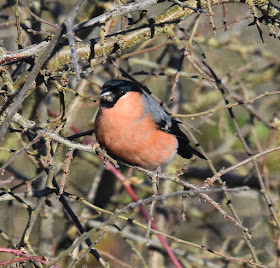 |
| Car park bud munching Bullfinch (c) Bark |
Yet again we were treated to a carbon copy of the previous
weekend with a sour, soggy Saturday followed by a contrasting sunny, sparkling Sunday.
 |
| Redwing (c) Bark |
Water levels across the moor have risen still further and
after reed cutting during the week the water level on the southern lagoon has
risen to match that on the northern one. This will mean a stable depth can be
established, so that reedbed breeders will not have nests flooded or suddenly be
left high dry and vulnerable to predation.
 |
| Flushed by the Marsh Harrier (c) Bark |
There were substantial numbers of wildfowl on both lagoons
this weekend. At least thirty Pochard were courting and displaying in front of
the southern screen, amongst them was the leuchistic drake who seems to be
spending time with one of the females, his lack of colour does not appear to be
a disadvantage in the mating game.
 |
| "Luke" with a friend ! (c) Bark |
Yet again the Hawfinch was seen, this time twice on Sunday morning.
We wondered what it might be finding in the carpark field to feed on. When we
looked closely at the blackthorn it was possible to find shrivelled up sloes
still clinging to the branches and when the dry outer skin is removed inside there
is a small very hard stone. We speculated that they were forming part of the
Hawfinch diet, assuming they were not too small and hard for its bill. There will
of course be more sloe and damson stones on the ground under the bushes.
 |
| Bullfinches are much more approachable now in the carpark (c) Bark |
A Nuthatch is now using the feeders in the carpark field.
They have usually not been reported closer to the reserve than Sling Copse and
the Spinney, it may be that they are now colonising the oaks in the Roman Road
and coming in to feed from there. Whatever the case it is good to see them more
frequently.
 |
| Redwing on the bridleway (c) Bark |
Sunday was particularly noisy across the whole reserve but
especially Ashgrave and Big Otmoor. There are now hundreds of Canada Geese on
the moor and they were being especially vociferous as they start to court and
mate. The aggressive encounters of their pairings and territorial disputes
result in much trumpeting and honking. Out on Big Otmoor amongst the thousand
or so Wigeon and another thousand or so other mixed ducks were a pair of Egyptian
Geese. Although they are increasingly common elsewhere in the county they are unusual
down on Otmoor and especially so at this time of year.
 |
| Noisy Canada Goose (c) Bark |
The starling roost has declined steadily and is currently
less than a third of what it was at its peak. The flocks are still coming, but
their displays are much more fragmented and spread across the whole area. The
reeds that they roost on are much weaker, often flattened and damaged. People returning
from the roost have noted woodcock flying out from the Closes and the Car Park
Field to feed on Greenaways at dusk.
 |
| Sunbathing Blackbird (c) Bark |
 |
| Long Tailed Tits (c) Bark |
On Sunday morning there were three skylarks up singing high over
Greenways and I heard my first tentative chaffinch songs of the year. A Great
Spotted Woodpecker was drumming in the Roman Road and frog or toad was croaking
from the ditch beside the hide. Small signs of change I know, but at this time in
the winter it is these small events that anticipate spring and lift the
spirits.












No comments:
Post a Comment